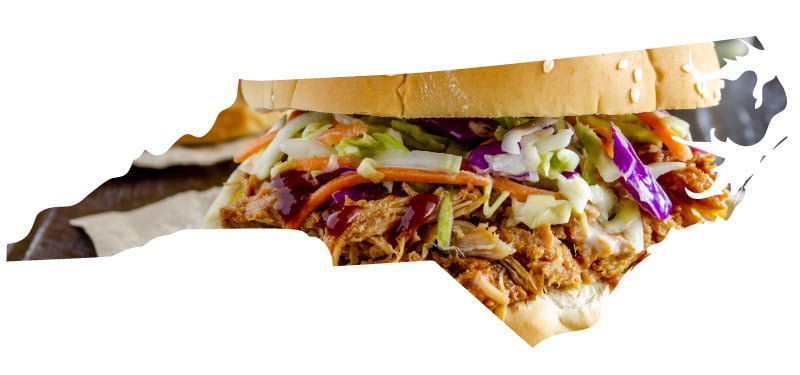
Barbecue styles can be as varied as the individuals in front of the smoker or grill. There’s no doubt, however, that certain regional cooking styles dominate their areas. From the Carolinas to Texas and from Kansas City to Memphis, barbecue styles represent the character and history of the regions that started them. Each area defines barbecue differently, with each considering their specific combination of meats, rubs, marinades, sauces, and techniques the best in the country. Discovering which style appeals to you the most can be a fun and mouthwatering journey.
North Carolina

In the Carolinas, “barbecue” is nearly synonymous with pork. A pulled pork sandwich (called a “barbecue sandwich” in many North Carolina restaurants) is a popular option. For serious barbecue connoisseurs, it’s all about the whole hog. The eastern part of North Carolina prefers a vinegar and chili pepper sauce and specializes in cooking the whole hog over an oak fire. After a few hours over low heat, the pork is pulled or chopped from the bone and served with a mayonnaise-based coleslaw. In the western part of the state, it’s more common to find “Lexington style” (also known as “Piedmont style”) pork shoulder barbecue with a tomato-based sauce. Even the coleslaw is different in the west, as it uses the same tomato base as the barbecue. Hush puppies (deep-fried cornmeal batter balls) are a popular side dish to serve with Lexington-style barbecue.
South Carolina

Like their neighbors to the north, South Carolina barbecue fans prefer pork. In their choice of sauce, however, the two states are worlds apart. Owing to the significant influence of early German immigrants, South Carolina barbecue is mustard-based. This might sound like an about-face from traditional barbecue sauces, but the tangy mustard flavor pairs perfectly with a slab of smoked pork. The spicy sauce is mopped onto the pork toward the end of the cooking process, leaving the meat tender and juicy. Combining the pit cooking methods taught by Native Americans with the pork brought over by the Spanish, South Carolina barbecue is a melting pot of flavor.
Texas

Heading west from the Carolinas, you’ll find Texas barbecue experts who highlight beef brisket rather than pork. Texas barbecue is often prepared with an uncomplicated dry rub and cooked low and slow over a smoky hickory-wood fire. In a state the size of Texas, there are bound to be variations. East Texas marinates their meats in a tomato-based sauce, often including ketchup and brown sugar for a sweeter flavor. Originated by freed slaves, this style of barbecue is cooked over indirect heat until fork-tender. West Texas favors the direct heat of a mesquite wood fire, while southern Texas goes heavy on the thick sauce. In central Texas, simplicity is king. Their barbecue often limits seasonings to salt and black pepper, with minimal sauces used but plenty of smoke flavor coming from the cooking process.
Kansas City, Missouri

Kansas City barbecue expands the palate, with nearly any protein considered fair game. Besides beef and pork, chicken and turkey are also welcome at the barbecue. In fact, when Henry Perry opened his barbecue stand in 1908 to feed workers in the Garment District, he sold whatever meats were available, including raccoon, possum, and woodchuck. Kansas City barbecue is often served with sides of coleslaw, baked beans, and potato salad. While meats are dry-rubbed during the cooking process, Missouri barbecue enthusiasts are passionate about their sauce. A hearty mix of a tomato base with garlic, molasses, red pepper, and brown sugar, Kansas City sauce delivers a tangy experience with just a hint of sweetness.
Memphis, Tennessee

In Tennessee, barbecue joints skyrocketed in popularity after World War II, as residents looked for inexpensive ways to treat themselves. Like in the Carolinas, Memphis barbecue focuses on pork, whether pulled from the bone or served as a large rack of ribs surrounded by sides. Memphis dry rubs are rich and complex, starting with salt and paprika but embracing all manner of spices, from garlic and onion to white pepper and cumin. Smoked until it falls off the bone, Memphis barbecue is often served with a tomato-based sauce on the side. In true Southern fashion, side dishes include collard greens, hush puppies, and fried okra.
Additional Resources
- The Two Styles of North Carolina Barbecue
- The Story of Barbecue in N.C.
- Origins of South Carolina Barbecue
- An Introduction to South Carolina Barbecue
- 12 Regional Barbecue Sauce Styles All Grill-Masters Should Know
- A Brief History of Texas Barbecue
- Kansas City-Style Barbecue
- Henry Perry’s Kansas City Barbecue
- What Makes Texas and Kansas City Barbecue Different
- Memphis-Style Barbecue
- What Exactly Is Memphis-Style Barbecue?
- History of Memphis Barbecue
- The History of the Barbecue
- American Barbecue History 101
- A Brief History of Barbecue
